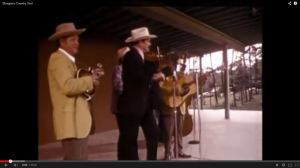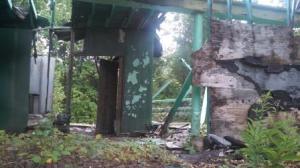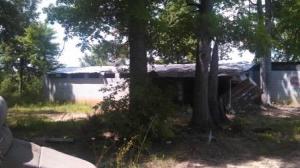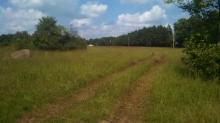By Art Menius, August 31, 2014
Barnum-like music promoter and artist manager Carlton Haney produced the first three-day bluegrass music festival with camping on Labor Day weekend 1965 on Cantrell’s Horse Farm near Fincastle, Virginia. Haney combined his and Bill Clifton’s idea of a big show with all the top bluegrass artists with the concept taken from Newport Folk Festival of a curated, multi-day festival offering some kind of narrative. Carlton capped off the three days with the “Blue Grass Story” on Sunday afternoon, creating a narrative arch for the community that brought the string tribe together. This was folklore being constructed on the ground. View 11 minutes from that first festival here,
After a second year in Fincastle, the original bluegrass festival moved to Watermelon Park near Berryville, Virginia for another two years. On Labor Day weekend 1969, the original festival arrived near Haney’s hometown of Reidsville, NC. On land besides Pat and Hazel Smith just south of Cherry Grove Road on the western edge of Caswell County, NC, Carlton built Blue Grass Park, the prototype for bluegrass festival venues for the next score.
There Carlton enjoyed his glory years, promoting bluegrass as a gospel, publishing Muleskinner News, telling the story, using up almost every ounce of energy Fred Bartenstein had. The theatrical documentary, Bluegrass Music, Country Soul, captured the third, 1971 festival. He added events there including the spring New Grass Festival, while also presenting famed festivals in Gettysburg and Berryville. By the late 1970s competition had grown fierce, while Carlton’s physical, mental, and financial health declined. Mike Wilson and John Maness helped promote three or four very presentable Labor Day weekend festivals during the middle 1980s, before the pair moved the event to Maness’ park.
At one of those events, Carlton took me up the house, still standing on site, which already looked as if vandalized in 1986. Painstakingly, while he was supposed to be stage managing, Carlton located each issue – in order from Vol 1, No 1 – in the chaos. He seemed to have maintained every check book he had ever owned, including banks long out of business. Meanwhile, Maness and the Bass Mountain Boys had been on stage for 75 minutes with no stage manager to wake up the emcee, Bill Hill. When Carlton return to livid Maness, Haney responded, “Art, show John what I gave you! The whole history of bluegrass music.”

Camp Springs stage in 1971, still from Bluegrass Music, Country Soul with Lilly Brothers and Tex Logan
The Saturday of Labor Day Weekend 2014, my wife Becky Johnson decided we should head up to Camp Springs for the 45th anniversary and see if we could still find Blue Grass Park. It did not prove easy. First, I made the mistake of turning off of Cherry Grove Road on to Camp Springs Road and driving fruitlessly up its 2 miles thrice. Finally back on Cherry Grove east bound, both Becky, who had only been there twice, and I felt drawn to turn right on Boone Road. After a couple of passes looking for the “Blue Grass Park” sign that was still hanging in the 1990s, we pulled up to a lonely gate with several no trespassing signs.
I had feared a trailer park. What we found was kindly worst. We followed the remains of the entrance road, passed a pine thicket where the band vehicles used to park between Boone Road and the stage area. Turning the corner, feeling like seekers of lost Mayan temples in the jungle, we faced heavy woods, thick underbrush, and to the right of an area where trash had been burned and cans and bottles dumped, stood the Carlton’s old bathhouse. Numerous no trespassing and one “Dead Man Walking if I Catch You Here” messages decorated the cinder block walls. Becky saw a sign warning of “Boobee” traps. The thought of a cannabis plantation crossed my mind.
We pushed through widespread poison ivy and briers as if no deer or other wildlife cleared the brush out in what was once the seating area. Finally like a red clay Angkor Wat, the remains of the stage, one so many festivals copied, stood before us in tatters. Where thousands saw New Grass Revival for the first time, where Tony Rice jumped ship from Bluegrass Alliance to J.D. Crowe, where Carlton told the Blue Grass Story, where Bill Vernon and Fred Bartenstein emceed, looked like a burned out mobile home. Carlton doing an impromptu version of the story with Mac Wiseman, Lester Flatt, and Chubby Wise at Renfro Valley, KY in 1971 can be seen here.
Something of “Kathaleen’s” Kitchen could be seen in the distance. More adventurous than I and possessing two good knees, Becky
took off through the underbrush and pine trees. She found a logging that took her to Carlton’s old house and the pond behind the stage.
We drove on to Milton, NC. We talked about Caswell County’s need for more tourism attractions and how Blue Grass Park reminded us of the once-overgrown Historic Occaneechi Speedway looked in Hillsborough, NC before citizens took action together to restore it. As many bluegrass music devotees are exist, cannot Carlton’s Blue Grass Park be saved in cooperation with Caswell County Economic Development and the Caswell County Historical Association to created a living historical site that tells the bluegrass music story while presented concerts and festivals.
-30-








Art – Thanks for giving us this important piece of bluegrass history. It captures the spirit that Carlton Haney embodied and some of the sense of risk always faced by bluegrass music if it refuses to grow and develop while treasuring its roots. This piece should be widely disseminated and often shared.
LikeLiked by 1 person
Much appreciated coming from bluegrass music’s top blogger!
LikeLike
Wonderful piece of bluegrass archaeology, thanks so much for this.
A few weeks ago, on the 45th anniversary of another famous musical festival, I explored the grounds of that event in Bethel, New York. Needless to say, the grounds of Max Yasgur’s farm are in slightly better shape than Carlton Haney’s joint.
LikeLike
Thank you, Art! Sure wish I could have been there in those days, as you, Fred and Becky were. You witnessed music history in the making.
LikeLike
Thanks for the article, Art. I would have been 12 years old at the time of the 1971 festival. In those days, I had zero interest in bluegrass or country music of any kind. How things have changed. I love the music and the history. I have a twenty year old son who began playing banjo at the age of nine. Due to his interest, some of his young friends began playing stringed instruments as well. They eventually became a sure enough bluegrass band called Sweetbriar Jam. Easy to find on youtube. They lasted for about 51/2 years. Now back to Bluegrass Park. Thanks to your description, I think I located it on google. I have the documentery, Bluegrass Country Soul, and I was wondering if the entrance to the venue on the video is the same as the one that exists now? And has Boone road had any changes over the years? I’m hoping to visit the location in the near future. I live 21/2 hours away in Caldwell County.
Thanks again, Roger Whitman
LikeLiked by 1 person
Thanks! Entrance road appears to be in same place, but everything looks closer to the road than I remember. The massive overgrowth makes it hard to compare
LikeLike
Pingback: Camp Springs Today Article in May 2015 Bluegrass Unlimited | Art Menius
Oh Wow, what memories this brings back! I was a young parking lot picker and attended festivals there from about 1974-80 and saw some of the greatest bluegrass artists ever perform on that stage. Just the fact that it still exists (albeit in such a degraded state) is amazing to see. It’s also a little bit eerie when I reflect on my own passage of time since then. Thanks Art for bringing this place back into the 21st century. It’s too bad that Carlton let it go like that; it could have been a national treasure if handled properly. Go back and watch “Bluegrass Country Soul” for a glimpse of what it was, although I like to think our hairstyles weren’t so goofy then! But the music was fantastic.
The most recent Bing aerial views show extensive logging in the woods behind the big field along Boone Road. It has been cleared all the way to the creek on the western edge, but the stage area, Kathleen’s Kitchen, Carlton’s office, the restrooms, and the general festival area has been left intact (at least at the time of the photos). If you have any more photos, please post them; I’ve seen the BU article (in fact that’s what led me here). Best Regards!
LikeLiked by 1 person
Hey Art, One more thing…if you look at the Caswell County GIS site (public land records) they use an aerial photo overlay from 2009. These photos show the stage roof to be completely intact at the time, so the structure damage you found happened rather recently within the past six years (since 2009) probably from wind/thunderstorm activity.
LikeLike